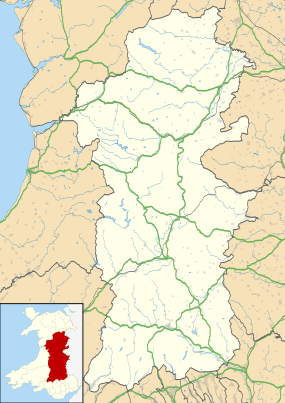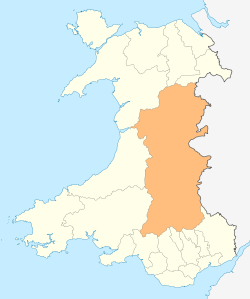Presteigne
| Presteigne | |
| Welsh: Llanandras | |
 Presteigne High Street |
|
 Presteigne |
|
| Population | 2,710 (2011)[1] |
|---|---|
| OS grid reference | SO315645 |
| Community | Presteigne |
| Principal area | Powys |
| Ceremonial county | Powys |
| Country | Wales |
| Sovereign state | United Kingdom |
| Post town | PRESTEIGNE |
| Postcode district | LD8 |
| Dialling code | 01544 |
| Police | Dyfed-Powys |
| Fire | Mid and West Wales |
| Ambulance | Welsh |
| EU Parliament | Wales |
| UK Parliament | Brecon & Radnorshire |
Coordinates: 52°16′28″N 3°00′19″W / 52.27436°N 3.00536°W
Presteigne (/prɛsˈtiːn/; Welsh: Llanandras (the church of St. Andrew)) is a town and community in Powys, Wales. It was the county town of the historic county of Radnorshire. Despite lying on a minor B road the town has, in common with several other towns close to the Wales-England border, assumed the motto, "Gateway to Wales".
The town sits on the south bank of the River Lugg, which forms the England–Wales border as it passes the town — the border effectively wraps around three sides of the town (north, east and south). Nearby towns are Kington to the south and Knighton to the north, and surrounding villages include Norton and Stapleton. The town falls within the Diocese of Hereford.
Presteigne is considered by Country Life magazine editor Clive Aslet to be one of Britain's top 10 small towns.[2]
History
Overview
The town probably began as a small settlement around a Minster church dedicated to St Andrew and at the time of the Domesday Book and formed part of the manor of Humet.
By the mid-12th century it was known as 'Presthemede' or 'the border meadow of the priests'. A century later, it passed into the control of the Mortimers, powerful Marcher lords, and on their fall passed into the hands of the Crown.
At the end of the 13th century, the majority of the town's inhabitants, mainly English, enjoyed some prosperity but the Black Death and the Glyndŵr rebellion had destroyed this and by the end of the 15th century, the now largely Welsh, population lived in a struggling village. A significant victory in their rebellion was won by the forces of Owain Glyndŵr nearby at the Battle of Bryn Glas in 1402.
The development of a thriving cloth industry in the Tudor period brought short-lived prosperity, ended by three new epidemics of plague in three successive generations. Thereafter it became a market town and, until the later 16th century, a centre for processing locally grown barley into malt.
By the Acts of Union, Presteigne - at first jointly with New Radnor - became the county town of Radnorshire and its administrative and judicial centre, housing the county gaol and the Shire Hall.
By the end of the 19th century its newer and larger neighbour, Llandrindod Wells, had usurped the role of administrative centre, but Presteigne remained the venue for the Assizes until these were abolished in 1971.
After a period of stagnation in the first half of the 20th century, the town has developed a diverse manufacturing base[3] and has begun to exploit its tourism potential while its environment and the development of its social, cultural and leisure facilities have helped to attract people to settle.[4]
Notable buildings
.jpg)
These include:
- The parish church, parts of which are Anglo-Saxon
- The Jacobean Radnorshire Arms hotel
- The Judge's Lodging, decorated in mid-Victorian style.[5]
Curfew
Presteigne attracted national attention in 2004 for an unsuccessful campaign by its Mayor, Councillor Peggy Fraser-Scott to enforce a curfew on the town's youth.[6]
John Beddoes
Henry Edward's Old English Customs: Curious Requests and Charities mentions the bell-ringer appointed by John Beddoes in 1565 to ring a 'day bell' at 8am, and a curfew at 8pm. Beddoes specified that in the event of the custom being abandoned for more than a year, (except in plagues) the funds set aside for this position would revert to his heirs.
Beddoes - a wool merchant - also gave his name to Presteigne's secondary school - John Beddoes School - which he established in 1565, and endowed with land.
World War 2
During the 1930s, the Ministry of Labour opened a work camp for long-term unemployed young men. Many of the inmates came from the crisis-hit coal mining, steel and heavy industry communities of South Wales. Presteigne was one of a number of Instructional Centres created by the Ministry, and it also had a satellite camp in Shobdon, Herefordshire. By 1938, the Ministry had 38 Instructional Centres across Britain. The camp was situated in Slough Lane near Hill Farm and is now a small private housing site. Land owned by Capt Lewis RN, of Clatterbrune House, was used to hold first Italian and then German POW's during the Second World War and is now the home of Presteigne St. Andrews Football Club.
Public transport
Sargeants provide a service (Monday to Saturday) to Kington with connections from there to Hereford on services operated by Sargeants, and buses in the opposite direction to Knighton. A once daily service from Ludlow to Builth Wells is also operated via Presteigne.
Railways
The Kington & Presteigne Railway opened as an extension of the Leominster and Kington Railway on 9 September 1875. The railway line commenced at Titley Junction, passed through Leen farm, to Staunton-on-Arrow, in front of the Rodd farm via Corton into Presteigne.[7][8] By 1929 it was possible to join one of the three steam trains a day - each way - and make the 6 hour journey to London. The passenger service on this line ended in 1951, but a freight service continued to run every other day until the line was finally closed for good in 1961.[9] Knighton is the nearest railway station, serviced by Arriva Trains Wales.
Notable people
- Royal Naval Captain Peter Puget and his contemporary, Captain Joseph Baker, another naval officer and map-maker
- Sir Christopher Hatton a courtier of Queen Elizabeth I
- Mary Morgan, a 19th-century murderer.[10]
- Grand Prix motorcycle racer and 2011 World Supersport champion Chaz Davies, born in Presteigne in 1987
- Bowls player and Commonwealth Games gold-medallist, Robert Weale was raised and educated in the town.
- Sir Standish Hartstonge, 2nd Baronet, politician, lived in Presteigne in the 1690s.
Art and culture
The town has become a local cultural centre. It hosts 2 indigenous festivals. First, the oddly named Sheep Music Festival dedicated to contemporary music;[11] and the Presteigne Festival of Music and the Arts[12] which casts a broader cultural net. It attracts composers of the calibre of Ian Wilson. The town has an award-winning museum - The Judge's Lodging.[13] - created from Radnorshire's disused Shire Hall and re-opened in 1997 by Robert Hardy. The Church of St Andrew permanently houses a 16th-century Flemish Tapestry. Presteigne was also host to the World's first competitive electric bicycle race[14] The town has inspired twelve songs for voice and piano - A Garland for Presteigne[15]
Bibliography
- Field, J. Learning Through Labour: Training, unemployment and the state, 1890-1939, University of Leeds, 1992, ISBN 0-900960-48-5 (work camps)
- Parker, K. A History of Presteigne (1977) Amazon link
- Parker, K. Radnorshire from Civil War to Restoration: A Study of the County and Its Environs 1640-60 in a Regional Setting (2000) Amazon Link
References
- ↑ "Civil Parish population 2011". Retrieved 1 November 2015.
- ↑ Clive Aslet (9 August 2006). "The Daily Telegraph". London. Retrieved 19 February 2007.
- ↑ "Applegate". Retrieved 19 February 2007.
- ↑ Keith Parker. "BBC". Retrieved 19 February 2007.
- ↑ "Official Site". Retrieved 19 February 2007.
- ↑ "BBC". BBC News. 22 April 2004. Retrieved 19 February 2007.
- ↑ "Kington Town Site". Archived from the original on 9 December 2006. Retrieved 19 February 2007.
- ↑ "Google Mapping - route of the Kington & Presteigne Railway". Retrieved 1 June 2008.
- ↑ "Herefordshire County Council". Retrieved 19 February 2007.
- ↑ "History, Powys". Retrieved 19 February 2007.
- ↑ "Sheep Music". Retrieved 19 February 2007.
- ↑ "Presteigne Festival". Retrieved 19 February 2007.
- ↑ "The Judges Lodging". Retrieved 19 February 2007.
- ↑ "The Daily Telegraph". London. 29 April 2006. Retrieved 19 February 2007.
- ↑ "Amazon". Retrieved 19 February 2007.
External links
| Wikimedia Commons has media related to Presteigne. |
| Wikisource has the text of the 1911 Encyclopædia Britannica article Presteign. |
- Presteigne and Norton Website
- St Andrew's Church
- The Bells of St Andrew's Church
- BBC mini-site
- Useful local information and maps showing historical sites in the area
- Photographs on Geograph
- Green Presteigne Wiki
- Presteigne St. Andrews Football Club
- The Judge's Lodging
- Holiday accommodation on the area
